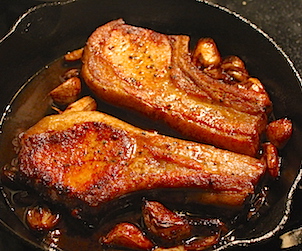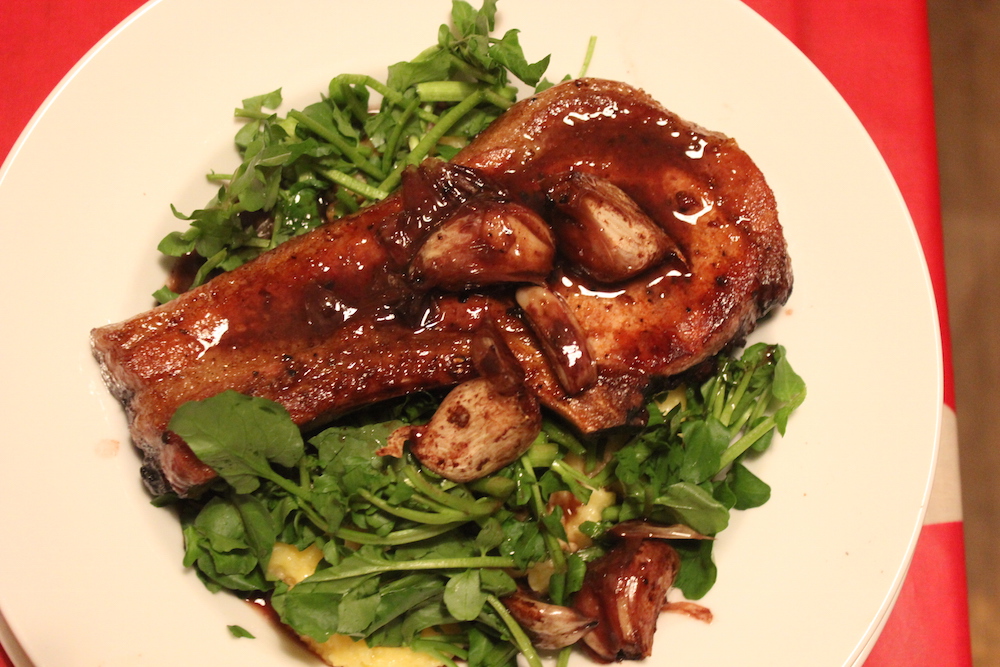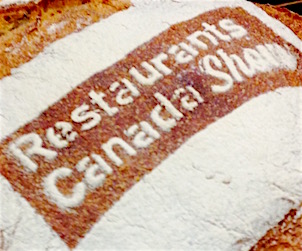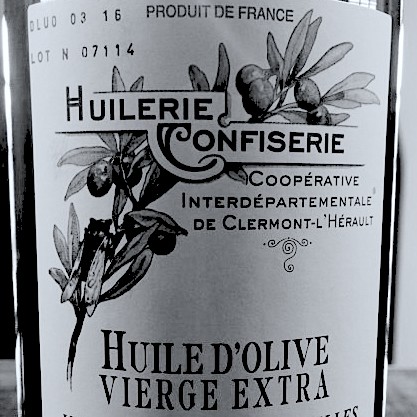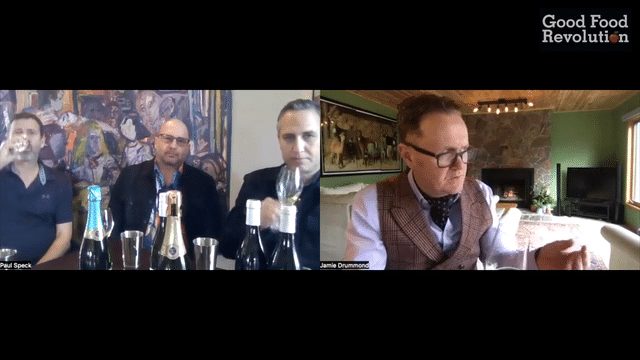I feel the same way about January detox as I do about shooting cartoonists: depressed, then angry. So, let this post be a weapon against those who might condone either barbarous thing. They are both a crime against Western civilization and it behooves us all to resist them.
I am only being half facetious. I don’t mean to make light of the horror of what has just is still happeneding in Paris. Je croix que nous somme tous Charlie à GFR et je suis serieux. I am also serious about fighting the quackery of detox and the humourless fundamentalism (of whatever origin, theological or not) that would deny us basic human pleasure. Enough. It’s madness in winter: we need comfort in food and wine at this point in the year more than ever.
Hugh Fearnley-Whittingstall’s The River Cottage Meat Book is now a decade old, and for 10 years or so one of his recipes has been a winter stand by for my wife and me: Pan-to-Oven Pork Chops with Garlic. Over the decade we’ve perverted the recipe slightly to suit our tastes and Canadian locale, but it’s certainly F-W’s. Still, for this week and time, I’m calling my bastardized version ‘Charlie’s’ for its explicit opposition to the January detox, and its nod to the French and European gastronomy: pig, wine and garlic are the basic ingredients. These days, to cook and enjoy this dish is an act of resistance.
Apart from its metaphysical significance, this pork chop dish comes with three important practical advantages. The first is that it becomes an easy one dish meal. The technique is simple: one fries up a chop or two in a pan with a few whole and unpeeled cloves of garlic until everything’s good and brown, then add some wine and finish it off in the oven so the pig bits, garlic and wine combine to make a tasty reduction.
In Fearnley-Whittingstall’s original version, which has been handily reproduced online here, he transfers the chops and garlic into a second dish to cook in the oven. This makes sense if you have to brown more than (say) two chops in your pan and need a bigger dish to cook all the chops in the oven at once. If, however, you can fit however many chops you intend to cook in your pan, and your pan is good to go in the oven, you can skip the transfer and simply add wine to your pan before moving it from the stove to the oven. Also, Fearnley-Whittingstall’s orginal version of the recipe serves the pork chops on mashed potatoes and “steamed leafy greens”. In our kitchen, my wife and I often substitute a simple polenta for the mash, and almost always use fresh watercress for a crunchy contrast; the bitter and peppery watercress balances nicely with the sweetness of the wine reduction.
The second practical advantage of this dish is that it’s a great way to use up leftover mashed potatoes and, more importantly, stale* wine. My fridge door is nearly always populated with one or more stranded bottles of wine. It’s usually red from bottles that were opened, then abandoned, towards the end of an evening. While I mean to get to them the next day or so, I usually forget about them because they’re out of sight, so I open new bottles instead. This is another way we deviate from Fearnley Whittingstall’s original recipe: he uses white wine, and we tend towards red because that’s what’s on hand. Actually, it’s a bit of a seasonal marker: in the winter there will tend to be more open bottles of red in the fridge, whereas in the summer there’s a greater possibility of whites. Red wine makes for a slightly heavier dish suitable to cold temperatures and vice versa. Another beauty of the recipe is that the pan will pretty much take as much, or as little, wine as you have on hand to cook with. Fearnley-Whttingstall says to use a cup, which is a third of a standard bottle, but you can make do with a little less and can certainly use more, with a worse case scenario that you might reduce your sauce a little bit more after the chops are cooked.
The third and final practical advantage of this dish is that it leverages the sad state of fresh vegetables in winter. It’s made for hearty watercress, kale, chard or whatever transported up from warmer parts of our continent at this time of year. And it works well with the sad old garlic that even the best grocers are stocking now. And you don’t even have to peel them.
So that’s it: vive la résistance. Keep opening bottles of wine this month, if you want. And keep eating well. The basics of this dish are simple enough. It’s really just pork chops, garlic cloves and wine.
*By stale I really mean oxidized: wine that’s exposed to oxygen for a long enough period of time will lose its fruit driven flavours and develop unpleasant alcoholic ones. Cooking the wine cooks off these unpleasant things as it cooks off the alcohol and gives the wine a new life as a sauce. This trick only works with stale wine; wine with other faults like cork taint will make an unpleasant sauce.
 Malcolm Jolley is a founding editor of Good Food Revolution and Executive Director of Good Food Media, the company that publishes it. Follow him on Twitter or Facebook.
Malcolm Jolley is a founding editor of Good Food Revolution and Executive Director of Good Food Media, the company that publishes it. Follow him on Twitter or Facebook.

